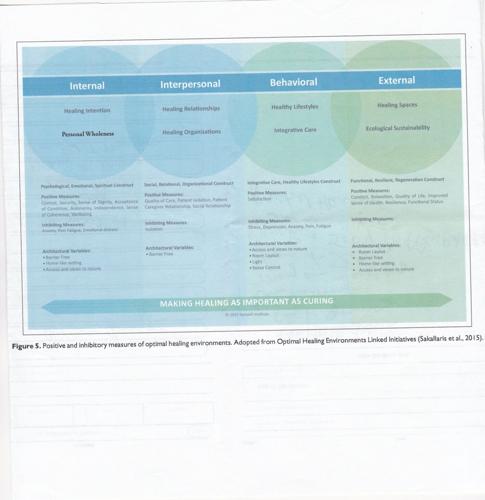Exploring the Concept of Creating a Healing Space
A holistic person-centered approach, which encompasses four domains: Internal, Interpersonal, Behavioral and External
To measure the process, you must first look at:
Changes in sensations and feelings.
Changes in self-concepts and values.
Changes in medical symptoms and complaints.
Constructions of meaning or cognitive reframing.
Some examples of these processes working include reduced stress, reduced anxiety and improved mood along with the physical and medical evidence of healing. It is a process that takes time, and it is valuable for dopamine production to acknowledge the process and even find pleasure in the results. The environment affects thoughts and feelings, which can be elevated with natural views, lighting, music and architectural design that contribute to the ability to self-manage as much as possible.
Making Home a Healing Environment
Here are some simple changes on evidence-based design… First, focus on the areas you spend the most time in. Items from nature are good for your health, natural light, views of nature through windows or skylight, scenes of nature in artwork, flowers or house plants.
Next, decorate your home with uplifting meaningful things, like family and friend’s photographs, religious symbols, meaning full objects and especially personal artwork. Third, reduce clutter, clean and create a quiet space for reflection or meditation. Also consider safety such as removing throw rugs, marking step ups or down, safe step ladder, etc. Fourth, use colors that are uplifting yellow can energize and blue, green and violet are calming. Lastly, create a bedroom that encourages “sleep hygiene” very dark, with low light for night commode trips, red light on clocks, no tech and bedding that is soft to the touch. Keep the room cool and maybe a weighted bedspread to help you attain a deeper sleep.
Two members in our class epitomize this process. Roy Stigers numbers at his last checkup have improved instead of deteriorating and playing 18 holes again after less than a year. Ronnie Robson has also bounced back after numerous setbacks in the last couple of years. Both have a fantastic fast sense of humor. All in the group improve and contribute to the community support for each other.
Have Fun and Live Life to the Fullest
In this type of class, there are two purposes:
To build muscle mass to recover lost strength and functions.
To counter act the neurologic deficits that occur and to prevent the progression of the disease symptoms.
We do this with weighted movements, education at every session and sharing experiences, strength and support for one another.
We are listed in HOA-1 under exercise and support; Classes are available on Mondays at 12 p.m. in the Fitness Center and on Tuesdays and Thursdays from 1:30 p.m. to 3 p.m. in HOA-1 Arts and Craft Center, room 3. Located next to the Gift shop. All are welcome! We have our quarterly support and educational meetings on the third Thursdays in 2024. Upcoming meetings will be on Thursday, January 18, Thursday, April 18, Thursday, July 18 and Thursday, October 17. For more information on Parkinson’s and for support, visit pmdalliance.org.
You can reach Vera Shury, Neuroplasticity Coach and HCH Coach at (520) 275-8755 or send an email to vera@liberty science.com.




